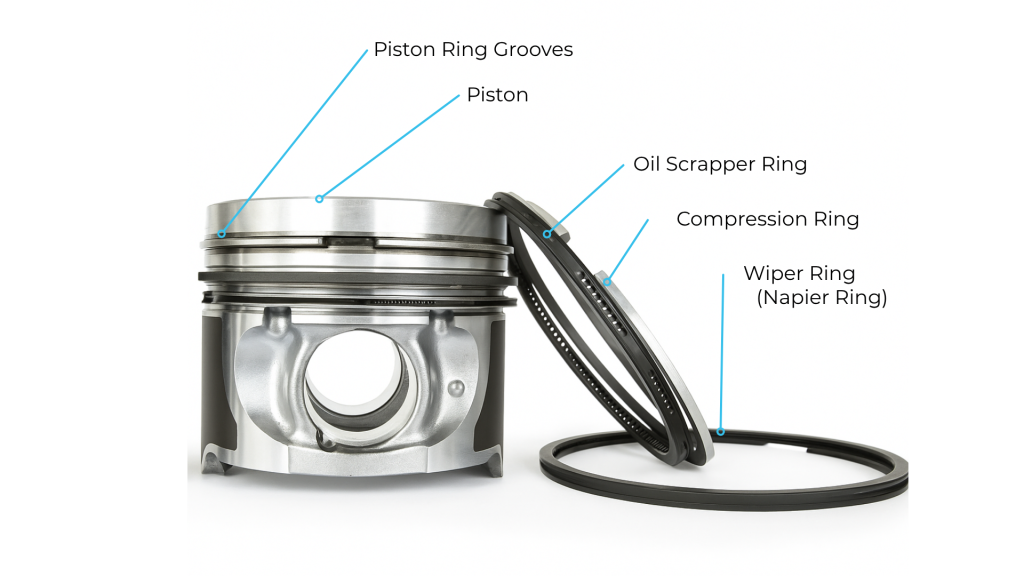
- 12 Aug, 2025
Marine engines depend heavily on piston rings to ensure sealing, heat transfer, and oil control. In this article, we explore the purpose of marine piston rings, the different types used in marine engine applications, and how material composition and coating solutions enhance their performance.
What is a Marine Piston Ring and Why is it Important?
A marine piston ring is a critical component located on the piston of an internal combustion engine. Its primary role is to seal the combustion chamber, preventing high-temperature gases from leaking into the crankcase. This ensures maximum compression and efficient power generation, especially in large 2-stroke marine engines.
Beyond sealing, piston rings also transfer heat from the piston to the cylinder liner, allowing excess thermal energy to dissipate into the engine’s cooling system. Finally, they regulate lubricating oil by scraping excess oil from the liner surface, preventing it from entering the combustion chamber and contributing to harmful exhaust emissions. Without well-functioning marine engine piston rings, a vessel's performance would rapidly deteriorate due to blow-by, frictional power loss, and increased oil consumption.
Types of Marine Piston Rings and Their Roles
Marine engines typically use a combination of three piston ring types, each designed to serve a specific purpose.
Compression Rings
The compression ring, also known as the pressure ring, is located at the top groove of the piston. It is responsible for sealing the combustion chamber and transferring heat from the piston to the cylinder liner. In both 2-stroke and 4-stroke marine engines, these rings form the first line of defence against gas leakage and thermal damage.
Wiper Rings (Napier Rings)
Below the compression ring sits the wiper ring, often referred to as the Napier ring. Its tapered face scrapes excess oil from the liner surface and acts as a backup to trap any gases that manage to bypass the compression ring.
Oil Control Rings
The third type is the oil control ring, also called the oil scraper ring. This ring regulates the oil film on the liner by evenly distributing and removing excess oil. It often features holes or slots to channel oil back to the crankcase. Oil control rings are especially vital in 4-stroke engines, where crankcase oil comes into direct contact with the cylinder liner.

Common Materials and Coatings for Marine Piston Rings
Marine piston rings are commonly manufactured from cast iron due to its natural lubricating properties and durability. Alloying elements like chromium, molybdenum, vanadium, and nickel are frequently added to enhance wear resistance, strength, and thermal stability.
To further boost efficiency and longevity, surface treatments are commonly applied to reduce friction, minimise wear, and extend service life. Conventional methods include electroplated ceramic chrome, hard chrome, nickel plating, thermal spray cermet coatings, and Chemical Vapor Deposition CVD with amorphous hydrogenated carbon (a-C:H) films.
NTI Nanofilm’s i-TAC® Coating Solution
Applied via Filtered Cathodic Vacuum Arc (FCVA) technology, NTI Nanofilm’s proprietary i-TAC® coating offers a next-generation solution that outperforms traditional treatments. Engineered for superior hardness, reduced friction, and exceptional adhesion, i-TAC® significantly improves sealing performance, oil control, and durability. It is suitable for marine engines of various bore sizes and is compatible with both 2-stroke and 4-stroke marine engine applications.
| Property | i-TAC® |
| Coating Material | Ti + ta-C |
| Hardness (HV) | 1,500 ~ 3,500 |
| Friction Coefficient | < 0.1 |
| Deposition Temperature | < 150℃ |
| Coating Thickness (μm) | 5 ~ 20 |
Interested in getting your piston rings better protection?
Contact NTI Nanofilm today to discover how i-TAC® coating can significantly upgrade your piston ring performance.
